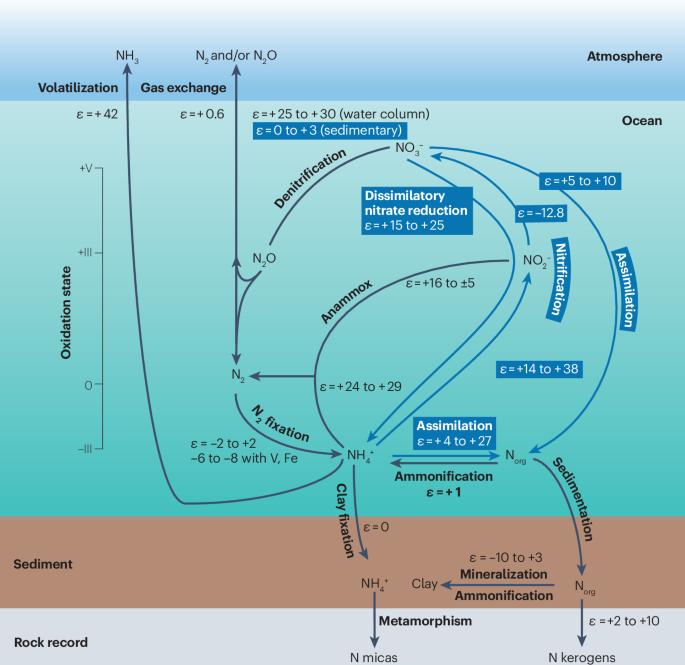Marine biogeochemical nitrogen cycling through Earth’s history
引用次数: 0
Abstract
Earth’s marine nitrogen cycle has co-evolved with life and redox conditions over geological time. In this Review, we provide an account of nitrogen cycling in the world’s oceans over the past ~4 Ga, from the dawn of life to the modern day. Stable nitrogen isotopes from sedimentary rocks, paired with other proxies, provide evidence that the nitrogen cycle has responded to and perhaps modulated events such as the emergence of life, oxygenation events, major climatic perturbations, and mass extinction events. Before the evolution of nitrogen fixation, bioavailable nitrogen was supplied via processes such as lightning, photochemical reactions, meteorite impacts and hydrothermalism. The advent of microbial N2 fixation facilitated the expansion of ecosystems. Establishment of a marine nitrate reservoir in the Neoproterozoic (1,000–541 Ma) probably enabled eukaryotic algae to dominate ocean primary productivity. Phanerozoic nitrogen cycle transitions over 100-Myr timescales are associated with icehouse-to-greenhouse conditions. Short-lived perturbations occurred during mass extinctions and anoxic events, which are linked to evolutionary changes, climatic extremes and ocean stagnation. The impact of the terrestrial biosphere on the global marine nitrogen cycle remains poorly resolved and should be addressed in future research to help answer open questions about the spatial and temporal trends in nutrient availability over Earth’s history. The nitrogen cycle is connected to the evolution of Earth and life. This Review explores the trends and perturbations in the marine nitrogen cycle and highlights how the cycle responded and perhaps modulated major events over Earth’s history.

地球历史上的海洋生物地球化学氮循环
地球的海洋氮循环与生命和氧化还原条件在地质年代中共同演化。在这篇综述中,我们介绍了过去 ~4 Ga(从生命诞生到现代)世界海洋中的氮循环。沉积岩中的稳定氮同位素与其他代用指标相结合,为氮循环提供了证据,证明氮循环对生命的出现、富氧事件、重大气候扰动和大灭绝事件等做出了反应,或许还调节了这些事件。在固氮演化之前,生物可用氮是通过闪电、光化学反应、陨石撞击和热液作用等过程提供的。微生物固氮作用的出现促进了生态系统的扩展。新近纪(1000-541Ma)海洋硝酸盐库的建立可能使真核藻类成为海洋初级生产力的主导。新生代氮循环在 100-Myr 时间尺度上的转变与冰室到温室的条件有关。短期扰动发生在大灭绝和缺氧事件期间,与进化变化、极端气候和海洋停滞有关。陆地生物圈对全球海洋氮循环的影响仍未得到很好的解决,应在今后的研究中加以解决,以帮助回答有关地球历史上养分供应的空间和时间趋势的未决问题。氮循环与地球和生命的演化息息相关。本综述探讨了海洋氮循环的趋势和扰动,并重点介绍了氮循环是如何对地球历史上的重大事件做出反应和调节的。
本文章由计算机程序翻译,如有差异,请以英文原文为准。
求助全文
约1分钟内获得全文
求助全文

 求助内容:
求助内容: 应助结果提醒方式:
应助结果提醒方式:


